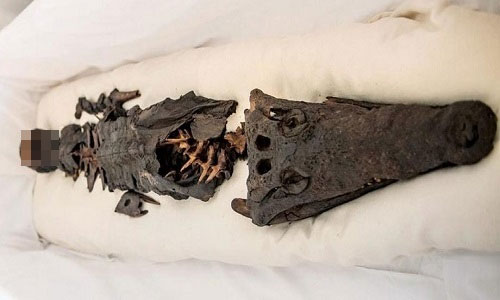Two-headed mummy sows fear in the Sultanate palace
The mummy was created from the head of the Egyptian princess, which was inserted into the upper half of the crocodile in the hope that the child would revive in the next life.
Ancient Egyptian mummy with two heads, a small child and a crocodile, was first revealed on July 6 after more than a century of exile by Sultan Abdulhamid II of the Ottoman Empire, according to Hurriyet Daily. News. Turkish authorities allow reporters to photograph the only mummy in Topkapi palace in Istanbul.

Mummy half-human half-crocodile in the Turkish palace.(Photo: Hurriyet Daily News).
Despite its extraordinary shape and interesting history, Topkapi mummies are not publicly displayed as six other mummies at Istanbul Archaeological Museum, which belong to important historical figures like Sidon's King Tabnit. Experts say the mummy consists of the head of an unknown Egyptian princess and the upper half of the Nile crocodile.
According to legend, the Egyptian princess was killed by crocodiles on the Nile. The king decided to combine the two bodies with the belief that the little princess would be reborn in the next life under the shape of the crocodile. The mummy was taken from Egypt to Turkey during the reign of Sultan Abdulaziz in the mid-19th century and located in the Yildiz palace in Istanbul until Sultan Abdulhamid II ordered it to be transferred to the older Topkapi palace. .
Turkish historian Hakki Konyali recorded an anecdote about the mummy in the 1950s. According to Konyali, people living in the Yildiz palace were terrified when they heard loud noises from the middle of the night storage. and saw the crocodile's head on his mouth. It was the joke of the servant Haci Süleyman to avenge the candy maker for the royal family for refusing his request. Later that night, Sultan Abdulhamid II transferred the mummy to avoid fear for everyone at the palace.
Scientists scanned a mature mummy crocodile.(Video: YouTube).
- The monks doubting the monk's hundred-year-old mummy had signs of revival and travel
- 7 most common fears in the world! Try reading if you have a friend in it?
- Fear of confusion
- Discover the mystery of the famous mummy
- 6 ways to help you control fear
- World famous mummies
- Admire the 10 most magnificent palaces in the world
- 8 bizarre fears of humans
- The truth about inner wells: No one dares to drink water for fear!
- 7 animals with two heads
- Strange fear syndrome that you may be suffering from but don't know how to call
- 10 mummies contain many mysteries
 Discovered an ancient centipede fossil 99 million years old
Discovered an ancient centipede fossil 99 million years old Discovered bat-like dinosaurs in China
Discovered bat-like dinosaurs in China Discovered a 200-year-old bronze cannon of the coast
Discovered a 200-year-old bronze cannon of the coast Discover 305 million-year-old spider fossils
Discover 305 million-year-old spider fossils